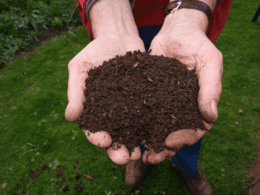Are you thinking of adding spaghetti squash to your garden? This squash is well known for its stringy flesh which when cooked has a texture and appearance like that of spaghetti. Growing spaghetti squash is very easy. In this article I will be going over everything you need to know about growing spaghetti squash, as well as how to tell when it is ripe and how to cook spaghetti squash. Let’s get started.
How and When to Plant Spaghetti Squash
Let’s begin by learning how to grow spaghetti squash. With the proper care, spaghetti squash can grow to be as big as 4 to 5 inches in diameter and 8 to 9 inches in length. However, it is important to know that spaghetti squash requires a long growing season and warm temperatures. Warm temperatures are needed even when planting the seeds. The days to germination are 10 to 14 days, and the day to harvest are 90 to 100 days. Spaghetti squash requires full sun, regular watering, and loose, fertile, and well draining soil. Here are the steps to growing spaghetti squash.
Plant the Seeds
Because spaghetti squash needs warm temperatures, many people choose to start their seedlings indoors until the weather outdoors is warm. You may find that you want to start your spaghetti squash indoors too, especially if the weather is very cold outside or if there is a chance of frost. Plant your seeds inside about a month before your local last frost date. Squash seedlings will grow fairly large in a month, so you won’t want to plant them in small 6-pack style seed trays. If you do plant them in such containers, you’ll need to transplant them to a larger container before you plant them outside. Three or four seeds can go in each 3 inch pot, about 1 inch deep under the soil. Keep your spaghetti squash seedlings somewhere warm and sunny so that they properly germinate and sprout. You have the option of keeping your spaghetti squash plant growing in a container, but you can also transplant it into the garden.
Transplant Them Outdoors
Plan to put your seedlings into the garden about 2 weeks after the date of your last spring frost. Dig into the soil to loosen it up, and mix in some aged manure or compost. One thing about squash it that it likes nutrients in its soil. Make sure the garden gets plenty of sun. Make sure you allow 3 feet between each hill.
If you are not starting with indoor-grown seedlings, you will still have to wait for 2 weeks past the frost date. If the weather is cooler out, you can lay black plastic down over the garden before planting to help warm up the soil. Keep in mind that the seeds won’t sprout in the cold, so there is no reason to plant them early. Plant them in hills, just like you did with the transplants, with about 3 seeds/seedlings per hill.
Caring for Your Spaghetti Squash
All plants need proper care, and so does your spaghetti squash plant. Keep the spaghetti squash well watered and weed-free while the leaves are developing. Once the wide leaves are fully grown, they will start to shade their surrounding soil and will keep the weeds out. But until their leaves are large enough to do so, you must pull the weeds in your garden.
During late summer, you should remove any new blossoms that your squash vines produce. There won’t be enough time left for them to mature and the plant’s resources would be better used growing the already-developing squash on the vine. Another helpful tip is to place tiles or coffee can lids under each growing spaghetti squash. That way the squash won’t rot, which is something that happens when the squash sits on the soil for a long time.
Protect Your Squash from Pests and Diseases
The most common insect that will try to damage your squash is the squash bug. Cucumber beetles will also try to damage it. Although a squash vine will be able to withstand insects once it is large and growing, you’ll want to protect it from insects while it is young. Make sure you check inside the blossoms and under the leaves for these pests. When you see one, remove it from the plant.
Diseases can also damage spaghetti squash. The most common disease your spaghetti squash plant can suffer from is mildew on the leaves. You’ll be able to tell if it has mildew because you’ll see white powder on the leaves. Mildew appears on plants when the weather is damp. The reason why mildew is so dangerous for your plant is because if it gets too heavy, it can effect your plant’s development and growth. Standard fungicide sprays can help get rid of mildew on your plants. To prevent mildew from starting, water your plants right at the soil instead of pouring water over all the leaves.

How to Grow Spaghetti Squash in Containers
Like I mentioned earlier, growing spaghetti squash in containers is an option. If you are wanting to try growing spaghetti squash in containers, you’ll want to first pick out a large container. It should be at least 5 gallons. Next, choose a variety that grows like a bush so that it saves on space. Orangetti or Tivoli are both great varieties to try. If you choose a vining squash, be prepared for the vines to spill out of the container a few feet. To make up for the lack of soil nutrients, you’ll want to give your spaghetti squash a light feeding part of the way through the growing season.

Image Source: Gardens Alive
How Does Humidity Affect the Growth of Spaghetti Squash?
Humidity levels play a crucial role in the growth of spaghetti squash. High humidity can impede pollination and lead to damp conditions that promote fungal diseases. To ensure a successful harvest, here are some tips for controlling grow room humidity: proper ventilation, using dehumidifiers or fans, monitoring moisture levels, and avoiding overwatering. Maintaining optimal humidity levels will help maximize the growth and yield of spaghetti squash plants.
How to Tell When Spaghetti Squash Is Ripe
Before you begin harvesting and cooking spaghetti squash, you must find out if it is ripe. Although spaghetti squash can ripen more once it is off the vine, it is better if it does its ripening on the vine. Of course, if the first frost is coming you will want to harvest your spaghetti squash. But if you have been thinking of picking your spaghetti squash just because you think it is ready, here are some tips for telling if your spaghetti squash is ripe or not.
- The first sign that the spaghetti squash is ready to be picked is if it has turned golden color or dark yellow. These two colors are what a ripe spaghetti squash should look like. Also, if the spaghetti squash looks glossy it is probably not ready to be picked.
- The vine should shrivel up, die, and turn brown when it is time for the squash to be picked.
- If you press your finger against a ripe spaghetti squash, it should be hard. A soft squash means it is not ripe yet.
If you must pick the spaghetti squash before it is ripe, make sure to leave a few inches of the vine on it. Also make sure to leave it in the sun to ripen. Spaghetti squash ripens the quickest when it gets plenty of sun. Once it is ripe, make sure you harvest and cook it so that it doesn’t go bad.

Image Source: Sproutabl
How to Cook Spaghetti Squash
Because the shell of a spaghetti squash is so tough, it may seem very difficult to cook. Thankfully, there are a few tricks. There are different ways to cook spaghetti squash, but the best way is to roast it. It is very easy to roast spaghetti squash in the microwave or oven. Here is how to do it.
Cut the Spaghetti Squash
The first thing to do is cut the spaghetti squash. Cut the squash from stem to end, but don’t try to cut through the stem. When you’ve cut through the squash, just pull each half apart. The force will pull one half away from the stem. If the squash is too hard to cut, you may need to soften it. To do this, cut it in a few spots (where you plan on slicing it into halves). Then, put it in the microwave for a few minutes. Do not microwave a whole squash longer than a few minutes, because steam could build up in the squash.
Scoop Out the Seeds
Once the spaghetti squash has been sliced in half, use a spoon to scoop out the seeds. If you like pumpkin seeds, you can save these seeds and cook them just like you would with pumpkin seeds.
How to Cook Spaghetti Squash in the Oven
It is possible to cook spaghetti squash in the microwave. In fact, that is the quickest way to cook it. But if you have extra time, roasting it in the oven is considered the best way to cook a spaghetti squash. To cook spaghetti squash in the oven, rub the inside of the squash halves with olive oil or butter, and then season with salt and pepper. For even more flavor, sprinkle some of your favorite spices onto the spaghetti squash.
Place the squash halves cut-side-down onto a rimmed baking sheet, and then roast until soft. By baking the spaghetti squash halves cut-side-down, the edges caramelize and brown. You’ll want the oven to be at about 375 F degrees, but adding or reducing by 25 degrees does not make much of a difference. You may want to add some herbs to your squash for added flavor.
How to Cook Spaghetti Squash in the Microwave
The quickest way to cook spaghetti squash is to cook it in the microwave. To cook spaghetti squash in the microwave, cut the squash in half, scoop out the seeds, and season with olive oil, salt, and pepper. Place the squash halves cut-side-down in a microwave-safe baking dish. Fill the dish with water so that it is about 1 inch deep. Microwave for 5 minutes, check the squash and continue to microwave for 2 to 5 minutes until the squash is soft and easily cut with a knife. Allow the squash to cool, and then scoop out the flesh with a fork.

Image Source: Inspired Taste
Final Thoughts
Spaghetti squash is an excellent squash to add to your garden. It is recommended to start growing it indoors, since spaghetti squash needs a lot of warm weather at the beginning. You can continue growing them in containers, or you can transplant them outside in your garden. Watch out for squash bugs and cucumber beetles that can damage the spaghetti squash. If you see one of those insects, pull them off right away. Do not harvest your squash until their shell is tough, they are dark yellow, and when the vine is dead. Spaghetti squash will ripen after being picked, but it is recommended to let them ripen on the vine. Once it is harvested, the best way to cook spaghetti squash is to roast it. In this article, I went over two ways to cook spaghetti squash: in the oven or microwave. Have fun growing spaghetti squash. Your hard work will hopefully result in a large harvest of spaghetti squash.










Finally! A great explanation for mildew, which I couldn’t solve just by fungicides alone. Thanks so very much!